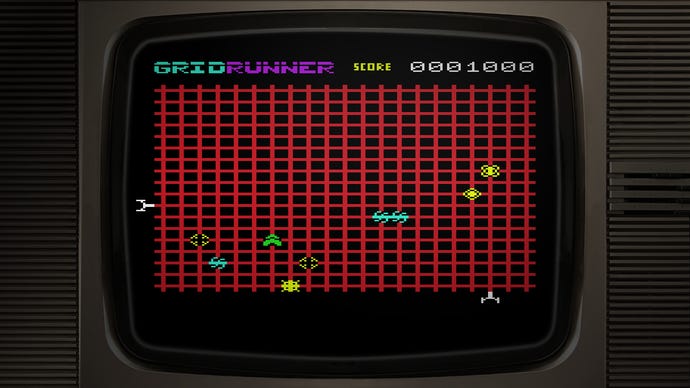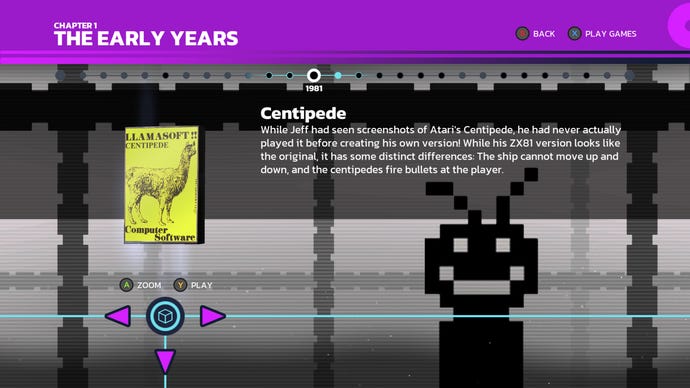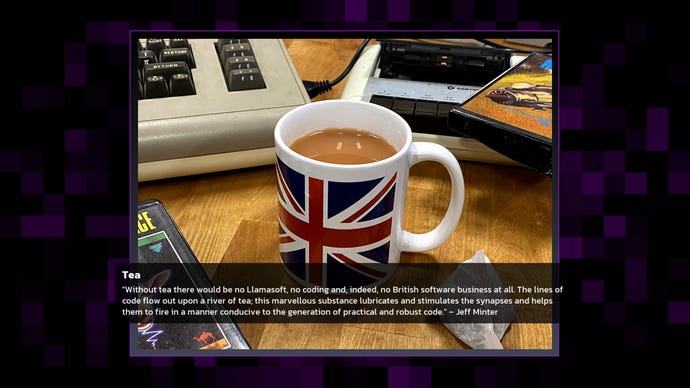Products You May Like
Who is Jeff Minter? Unless you’re a long-term fan of his work, you might have asked that upon hearing about Llamasoft: The Jeff Minter Story, the latest interactive documentary from Digital Eclipse (following on from The Making Of Karateka and Atari 50: The Anniversary Celebration). You might have heard Minter’s name in connection with the remake of the unreleased Atari arcade game Akka Arrh in 2023. Maybe you played his mind-warping shooter Polybius in VR. You might remember as far back as the Atari Jaguar and Minter’s phenomenal Tempest 2000, the unexpected highlight of the console’s library. Or perhaps you recall his work from the 8-bit glory days. You could just know him from the daily videos of him feeding his sheep on YouTube.
The point is that Jeff Minter has been making games for a phenomenally long time – more than 40 years, in fact. And in all that time, he has stayed true to what he believes in. “One of the things we say in the game itself is the idea of him being the last indie developer,” says Chris Kohler, editorial director at Digital Eclipse in California. “The last of the people from the early 80s who very consciously never sold out, never took the money, never looked to expand or do anything other than [be] just Jeff at his computer, making the sorts of video games that he wants to make.”
“There’s very few stories like that, there’s very few people like that, who have been doing that for 40 years,” he continues. “I’m struggling to think of another one. There are people who are still in games, but they progress up the managerial ladder, or they open up a studio, or they end up doing something else. Just to have somebody that started in 1980 just sitting there programming games, and who’s now still sitting in front of his computer programming games, it’s a very, very unique situation.”



The first Jeff Minter joint I played was Llamatron: 2112, an early 90s tribute to Robotron: 2084. It reimagined the classic twin-stick shooter as an utterly wild ride that saw you blasting toilets and telephones while rescuing camels and wildebeest, soundtracked by a cacophony of bleating and weird electronic noises. It blew my teenage mind that you could make a video game so incredibly strange and so completely unlike absolutely everything else. Kohler’s introduction to the Minterverse came a few years later. “The first I really heard of him was when Tempest 2000 came out for the Atari Jaguar,” he says. “And everybody was like, ‘Oh, well, you know, Jeff Minter made it, he’s this sort of god of shooter games in Britain’. But there wasn’t a whole lot of opportunity for me to play a lot of those games, because a lot of them were simply distributed by Jeff himself, sometimes literally making copies of cassettes and mailing them out to people in the UK.”
Llamasoft: The Jeff Minter Story finally gives everyone the chance to play through Minter’s back catalogue, going right back to the days of the Sinclair ZX81. But perhaps more importantly, it provides context for each game through video interviews, photos, quotes, magazine articles and even issues of Llamasoft’s newsletter, The Nature Of The Beast. Kohler thinks that this context is essential: “When you learn about what he was doing with each of those games, you’re going to have more of an appreciation for it when you actually play it,” he says.
It’s true. One of the earliest games in the collection is a clone of Atari’s Centipede for the ZX81, and once you’re told that Minter hadn’t actually played Centipede when he wrote it, it all makes so much more sense. By going solely on magazine screenshots, he missed the fact that your ship can move up and down as well as left and right. Yet he kept coming back to the gameplay of Centipede, and the collection lets you experience how Minter refined and expanded on it over the years. “You can see how he builds and builds and builds on that, and gets to the point where he’s remaking Gridrunner, which is really his version of Centipede, but just iterated and iterated and iterated,” says Kohler.

Gridrunner from 1982 is the first truly great game in Llamasoft: The Jeff Minter Story, although far from the last. Titles like Attack Of The Mutant Camels and Ancipital were wildly inventive, with each release invariably featuring llamas, camels or various other ‘beasties’ in some shape or form. You always knew when you were playing a Jeff Minter game. The mid-80s also saw the release of Psychedelia for the Commodore Vic-20, the first in a long line of ‘light synthesisers’. Minter explains in a video that he would often envisage abstract moving shapes in his head, and these light synthesisers were a way of representing that, featuring trippy patterns that could be manipulated in time to music. Minter would later go on to create light synthesisers for systems like the Jaguar and Xbox 360.
The missteps are arguably just as interesting as the triumphs, however, and the in-depth discussion of Mama Llama in particular is fascinating. It’s a vibrant, experimental game that sees the player defending a family of llamas from attack, and it divided critics at the time. There’s a candid interview where former Zzap!64 journalist Gary Penn defends his withering review – a review that Minter seems miffed about to this very day.
Minter also seemed to have an almost unerring knack for backing the wrong horse. In the late 1980s, he invested in an expensive development kit for the Konix Multisystem, a British console that could be configured with a steering wheel, flight yoke and motorbike handles. “This was going to be the UK’s home team advantage, as it were, for a gaming machine,” says Kohler. “Japan had Nintendo, America had Atari, and if you were British video game developer, this was going to be the one that was right in your backyard.” Minter was developing Attack Of The Mutant Camels ’89 for the Konix Multisystem when the console hit the buffers, and neither the game nor the machine saw the light of day. But thanks to a group of dedicated fans who were able to put together a Multisystem emulator with the help of the game’s source code, Attack Of The Mutant Camels ’89 is now playable as part of this Digital Eclipse collection.
“He went from the Konix Multisystem and then he said, ‘OK, all right, well, that was a big failure, so I’m gonna make games for the Atari Panther,” says Kohler of Minter’s ill-fated journey. “And then after that, it was, ‘OK, I’ll do the Atari Jaguar’, and then the Nuon, and then the GameCube, and he always seems to have this uncanny ability to just go right for the underdog. But ultimately that’s Jeff, and that’s that independent streak, where he’s not just gonna follow the crowd.”
The Konix Multisystem debacle represents the start of the Act 2 of Minter’s life, the point where, after years of widespread acclaim in Act 1, things start to fall apart, and it became increasingly hard for Llamasoft to remain independent. “In the 90s, he was fighting against the increasing commercialization of the video game industry,” says Kohler. “In 1981, he was on a level playing field, because practically everybody was just copying games to cassette tapes, and you can get distribution into retail channels that way. But around that time of Llamatron, he found that the doors were now closed to him in many ways. The cost of entry, the cost just to play in the video games industry had skyrocketed, and as that realisation came to him, he had to figure out, ‘How am I going to compete?’ So he decided to try shareware and see what happens, and the Llamasoft fans come in and they bail him out. They sent him the five pounds he was asking for, and some sent him even more than that.”

This sets up the triumphant Act 3, where Minter receives widespread acclaim for his reimagining of the Atari coin-op Tempest for the Jaguar. “The endpoint of our story represents everything that Jeff was doing all kind of coming together,” explains Kohler, “like his love for Atari, his love for arcade games and shooting games, and also his love for that sort of visual denseness, richness and complexity, his love for musical visualisers. Because that’s kind of what Tempest 2000 feels like: it’s a marriage of shooting gameplay and trippy psychedelic music visualiser.”
Kohler says that Digital Eclipse decided to stop at 1994’s Tempest 2000 partly because it felt like a good resolution to the story, but there were also some practical concerns with including Minter’s later games, such as Space Giraffe on the Xbox 360. “We wouldn’t have been able to emulate them or integrate them into our engine, basically,” he says. “Tempest 2000 is not quite totally topping out the capabilities of what we can do in the Eclipse Engine, but it’s getting there.”
Nevertheless, a timeline is included that includes every title for reference. “We do have the complete list of everything that Llamasoft released, even licenced stuff that we couldn’t include,” says Kohler, “So you can quickly go down and look at screenshots of everything, including the impossible-to-play-now iOS games that he that he did.”
But despite Minter’s influence, it’s still hard to see how a documentary of his work ended up being made by a Californian studio. Jeff Minter may be a lauded figure in the British development scene, but he’s much less well known in the US. The explanation is partly that Digital Eclipse president Mike Mika is a fan. “When he was getting into the games industry in the 90s when he was a teenager, one of the first people that he met was Jeff Minter,” says Kohler. “And he loved Jeff’s work, and Jeff was very helpful to him as he was getting into the games industry.” In addition, Digital Eclipse had previously operated as a work-for-hire company, producing titles like The Disney Afternoon Collection, but Kohler explains that a couple of years ago the company received funding to create its own titles internally, which has meant they’ve been able to pursue projects like The Making of Karateka and now Llamasoft: The Jeff Minter Story.
Kohler says that his distance from Minter’s homeland was an advantage in some ways when he was putting this collection together. “It’s probably easier, because I was approaching it from that perspective of an outsider, somebody who didn’t live through it,” he says. “Because I think when you live through it, and you’re surrounded by it all the time, you have inbuilt narratives that you’ve already told yourself about what happened in those days, and it can be difficult to break yourself off that.” Instead, Kohler went back to the source material, reading magazines like The Games Machine and Zzap!64, and he approached curation with the mindset that many people, especially outside the UK, might not be familiar with Minter’s career or even the landscape of the UK game scene in the 1980s, where the infamous 1983 crash never happened. “We’re going to people and saying, hey, you’ve never heard this story before, you’ve never played these games before. Let’s walk into another world, an alternate timeline almost, of a videogame history that you didn’t experience.”

Still, Kohler’s outsider perspective did result in one hiccup during development. “We sent Jeff the first build where he could really look at the timelines,” recalls Kohler. “I was prepared for him tocome back with ‘this is wrong, that’s wrong, that’s out of order, I don’t think this’, with all kinds of things. And I literally got one substantive comment from Jeff, one comment from him that was something that was wrong and needed to be fixed. And it was I had taken a public domain image of a cup of tea. And he has like, ‘This tea is absolutely wrong. The tea bag is still sitting in the tea, which we would never do in Britain, and there’s no milk in this tea. It is completely un-British’.”
Kohler sent me the original public domain image of this cup of tea, and I agree with Jeff that it’s a complete abomination. But thankfully the offending drink has been removed: Kohler went to great lengths to ensure the tea image in the final build is as British as possible, even ordering a Union Jack mug from Amazon along with some PG Tips, and picturing it next to a Commodore 64.
Tea and C64. It sums up Jeff Minter quite nicely, I think, someone who is emblematic of an explosion of creativity in the British coding scene, partly enabled by the UK market eschewing consoles in favour of computers. “In that eight-bit era, where the primary game playing systems are also game development systems, it supports the bedroom coder in a way that the Japanese and US markets at that point simply did not, because essentially they were playing on closed platforms,” says Kohler. Jeff Minter emerged from that era, but somehow he managed to carry on after his fellow bedroom coders had been absorbed into companies or left the industry entirely. He has stayed true to his love of psychedelic visuals, frantically paced shooters and farmyard animals, yet has also moved with the times, embracing new technology like VR. His plucky business run from a farmhouse in Wales has faced challenges along the way, but somehow Llamasoft has survived, and if anything has gone from strength to strength.
Who is Jeff Minter? He’s a legend.
